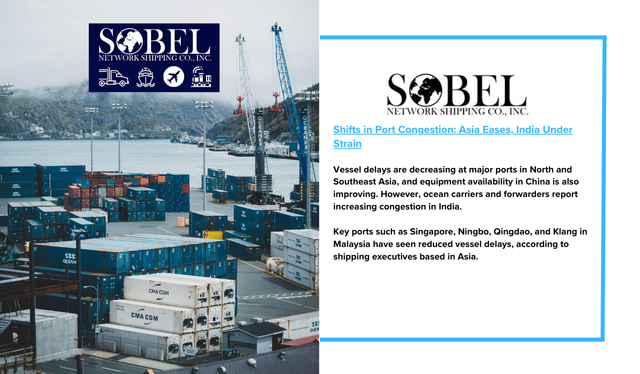Vessel delays are decreasing at major ports in North and Southeast Asia, and equipment availability in China is also improving. However, ocean carriers and forwarders report increasing congestion in India.
Key ports such as Singapore, Ningbo, Qingdao, and Klang in Malaysia have seen reduced vessel delays, according to shipping executives based in Asia.
“Congestion has eased slightly in Singapore as carriers are opting for ports in Malaysia, like Klang and Tanjung Pelepas,” a FIBS Logistics spokesperson told the Journal of Commerce.
Container volumes at Tanjung Pelepas have surged by 20% this year, partly due to diversions from Singapore. Similarly, Klang’s Northport experienced a 26% increase in container volumes in May, reaching 335,361 TEUs compared to the previous year, due to ad-hoc carrier calls.
“There has been a modest improvement in wait times of two to three days in Singapore, though it remains dependent on the carrier and service, and wait times are still significant,” a senior executive at a Hong Kong-based freight forwarder said.
Ocean Network Express (ONE) reported that sailings on its Asia-Europe Far East Pacific 1 service next week and in July are delayed due to severe congestion in Singapore. Delays, which were up to eight days at the end of May, have now reduced to up to five days on some FP1 sailings, according to vessel schedules.
Elsewhere, wait times have decreased to two days in Ningbo and less than 24 hours in Qingdao, compared to up to three days at the end of April, according to Hapag-Lloyd.
Data from Linerlytica indicates improvement in Singapore, with vessels totaling 286,778 TEUs waiting at anchorage on Thursday, down from 350,281 TEUs on June 15. However, vessel numbers and total capacity waiting to berth have increased since early May, when only 42,290 TEUs were at anchorage on May 1.
Equipment availability in China has improved since early this month. More 20-foot and 40-foot containers are available in Dalian, and 20-foot equipment is more plentiful at ports in Taiwan.
“Overall, the container shortage in China has improved, but there is still tight supply in central China, especially in places like Wuhan,” said the FIBS Logistics spokesperson.
Mundra Under Pressure
While conditions have improved in China, Singapore, and Malaysia, India’s largest container gateway, Mundra, is facing increased pressure from rising transshipment volumes. Some carriers operating between Singapore and Dubai have reduced sailings at Mundra to expedite returns to other Asian ports.
Trade updates indicate that container dwell times at Mundra have significantly lengthened over the past few weeks due to slow import clearance in congested container yards. Indian container rail operators (CTOs) blame the port for train turnaround disruptions, which are causing additional charges for importers.
CTO sources report yard backlogs for railed freight are now 15 to 20 days, compared to the usual seven to nine days. Approximately 50% of Mundra’s traffic moves by rail.
The Association of Container Train Operators has suggested that the situation may require a force majeure declaration from the port authority. The Container Shipping Lines Association (India) has urged the port to take immediate action to improve cargo flows.


